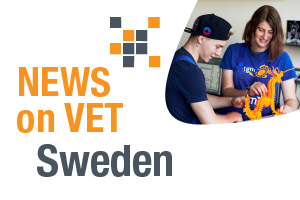The new concept of higher vocational education and training (VET) courses has been a great success. Since their launch in 2020, more than 20 000 learners have enrolled in courses, which aim to reskill and upskill professionals. A survey published in 2022 showed that the learners were very satisfied with this new learning concept.
The Swedish labour market is mainly governed by collective agreements between social partners. One of its features is a weak alignment between the skills needed on the labour market and the actual skills workers have. In response to this, in the end of 2020 the government agreed with social partners to reform labour market policies and develop further measures for funding the implementation of continuous professional development (CPD) and retraining programmes. The higher VET courses created are in line with this policy, offering training to professionals who need to renew their skills, move on to new and more advanced positions or change career paths. These courses are of shorter duration than the existing higher VET programmes (EQF-levels 5 and 6) and do not lead to full qualifications. They are also flexible regarding their mode of delivery (campus, distance or remote) and study pace (full-time or part-time); this way they also attract learners who wish to combine work and education. Higher VET courses are adaptable and change over time in response to the skills needed on the labour market. Most courses are offered in the fields of digitalisation and automation, green technology and energy efficiency.
Funding
The National Agency for Higher Vocational Education (Myndigheten för yrkeshögskolan, MYH) has funded about 450 courses for 20 000 learners since 2020 at an annual cost of approximately SEK 150 million (about EUR 13.7 million). The budget to support the individual learners comes from the State and the total budget aimed at funding individuals’ participation in retraining and CPD programmes is estimated to be SEK 11 billion per year (about EUR 1.01 billion) for the period from 2021-26.
Participation
Since their introduction, the higher VET courses have been in great demand – particularly during the pandemic, as many people were temporarily laid off. According to a recent survey, the most common reason for students to apply for courses is to improve their chances in the labour market, while the second most common reason is to upgrade one’s skills in response to new demands in their current profession and position. An overwhelming majority believes they will benefit from the training in their working life.
When applications for the CPD and retraining programme opened on 1 October 2022, the Swedish Board of Student Finance (CSN) administering the programme expected some 5 300 applicants until the end of the year. Instead, the response was overwhelming with more than 7 700 applicants in 1 week and 14 000 applicants in less than 2 months.
Looking ahead
An area for improvement is for employers to engage more in CPD for their employees – particularly since it is provided through public funding. So far, most learners of the higher VET courses have studied solely during their spare time, with employers only being involved to a small extent.
As a next step the MYH aims to examine the potential for piloting the higher VET courses as opportunities for awarding Swedish micro credentials.
Read more
- Studerandes upplevelser av kurser i yrkeshögskolan - resultat från enkätundersökning 2021 [Students' experiences of courses in universities of applied sciences – survey results]
|
Please cite this news item as: ReferNet Sweden; Cedefop (2022). Sweden: higher VET courses – a success story. National news on VET |
